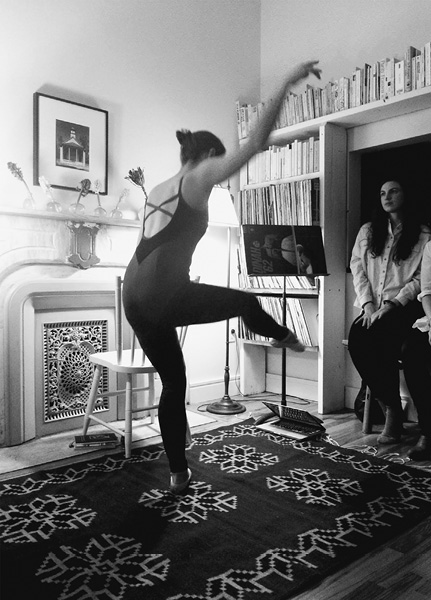
THE DRUG OF CHILDHOOD
first performed on March 17, 2016
BUFFET, poetry and performance series in an apartment in Harlem, New York, NY
performed once in 2016
MARGARITA DELCHEVA
Brooklyn, NY / Goleta, CA
THE DRUG OF CHILDHOOD
MARGARITA DELCHEVA
This dance performance was set to music by Mihály Vig from the films of director Béla Tarr. At the beginning, I wore pointe shoes. I held onto the back of a chair, performed a ballet barre plié and port de bras sequence, while reciting the poem “(4)” from Stone by Osip Mandelstam. I span and began an adagio while reciting the poem “A Kiss on the Forehead” by Marina Tsvetaeva. I ended the recitation by mixing the ends of both poems. I sat on the back of the chair, taking deep breaths. I put my face in my hands. I came down from the back of the chair and started taking off my pointe shoes. The performance up to this point had a serious, melancholy mood.
The music changed to a more upbeat composition. I finished taking off my pointe shoes and began to clown, disassembling a set of Russian dolls. I held one of the pieces between my teeth, making exaggerated gestures with my arms. I placed the small Russian dolls inside the larger ones, ending up with two sets of “maracas,” which I shook as I danced about the space.
I proceed to take apart the Russian dolls once more, “swallowing” the tiniest Russian doll as a “pill” with a drink of water from a bottle. The playful and chaotic dance continued with increased tempo until I doubled over and splat on the floor, breathless. I looked up one final time with a mischievous stare.
The motivation behind this performance was to portray the connection between aesthetic experience and the expansive wonder of childhood. The structured ballet sequences and the tragic, existential mood of the poems opened the space of childhood through Mandelstam’s mention of the theme. When my character took the “pill” of childhood, represented by the smallest Russian doll, she channeled a wilder and more energetic side of herself.
Mandelstam’s poem celebrates the appreciation of simple objects and activities that only children can have. By taking “the drug of childhood,” we can attempt to see our lives in such a way. Where do we look for this drug or cure? Do we have to take ourselves apart to find the smallest Russian doll? Is the cure inside us? What does it take to access it?